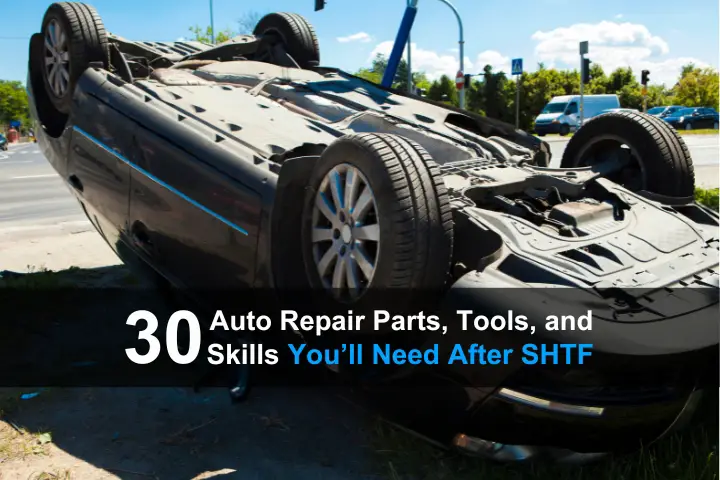Of all the concerns you might have after the SHTF, getting the oil changed on your car might seem like the least of your worries – until you have to bug out. And even if you don’t have to bug out, getting around town is a lot easier and safer in a vehicle, assuming you have some gas stockpiled.
The point is, there are plenty of disaster scenarios where having a working vehicle will be very important, whether it’s a short-term emergency or a long-term crisis. What are you going to do if your car won’t start and there aren’t any repair shops?
If you think back to the height of the pandemic, essential services were still available – to some degree. Now multiply those effects by 10 or 20 and you can imagine what societal collapse might look like: All the stores are closed and basic auto parts are impossible to find. That’s a bad time to have a dead car in the driveway.
Some people will be lucky. They may already have the skills or know a family member or neighbor who is well versed in auto repair. But what if you’re stranded with a breakdown on the road during a bug out? The simple fact is that auto repair skills will become just as necessary as the other basic skills.
This isn’t about filling a bag with tools and equipment. We’ll get to that later. The first step should be acquiring knowledge of vehicles, their operation, and most importantly, how to maintain and repair them. To start, buy some books. But not just any books.
You need the information and the knowledge about how to fix components on your particular make and model of vehicle plus the vehicle year. It’s unlikely that most of us will have the time to learn and practice everything, but these manuals can give you a fighting chance if you’re encountering a problem or repair for the first time. Some of these books you should keep at home but some should be in the vehicle at all times.
Want to save this post for later? Click Here to Pin It On Pinterest!
Books In the Vehicle at All Times
The Owner’s Manual
These manuals usually focus on how to operate various features on your vehicle; explains the meaning of warning lights, offers schedules for routine maintenance, and some suggestions for very basic repairs or adjustments.
Vehicle Specific Repair Manual
These manuals get into a range of repairs from basic to complex. They are customized to the year, make and model and can be found on Amazon where it’s easier to search for the specific manual for your vehicle.
General Vehicle Repair Manual
If you don’t have a vehicle specific repair manual you should at least have a general vehicle repair manual. They’re sometimes dated to the general years or decades for a vehicle and sometimes are specific to types (autos versus trucks versus SUV’s).
Books At Home and Possibly in Your Vehicle
There are books that take your through the concept and approach for vehicle repairs plus an exploration of the specific types of tools and how to use them. These books often offer troubleshooting tips for noises or vehicle behaviors in addition to general approaches for repairs.
Auto Repair for Dummies
Ignore the title. These books are actually quite informative and if you are new to doing any and all vehicle repairs they cover things in depth and accurately.
How to Diagnose and Repair Automotive Electrical Systems
How to repair all things electrical and electronic in most vehicles.
Auto Repair for Beginners
Described as “The Ultimate Step by Step Guide on How to Repair and Care for Vehicle, Car and Truck without Prior Knowledge or Experience.”
Auto Engine Repair
A mechanics textbook described as: “Auto Engine Repair teaches students to diagnose, service, and repair all makes and models of gasoline and diesel engines. Content details how engines and their related systems are constructed and how they operate.”
Apps
Yes, when it comes to vehicle repair –there’s an app for that. What’s great about an app on your phone or pad device is that you might have it with you on the road if the books are left behind.
This first app links to a plug in Bluetooth device that reads your vehicle computer chip for diagnostics. It’s called FIXD and comes highly recommended and works with both iPhones and Android.
There are also general repair apps that can give some guidance on what to do if your vehicle encounters a problem. Here’s a link to an article about 17 free auto repair apps.
Practice if You Can
Vehicle maintenance is a big part of reliable vehicle operation. Start doing your own maintenance. Change the oil. It’s not easy (although it used to be easier) but figure it out. Change an air filter. Check the tires and inflate them to the recommended pressure.
And while you’re at it, figure out how to read the printing on the side of a tire to determine the right air pressure.
Doing some routine maintenance on your vehicles is a great way to get your mind into the idea of doing some serious repairs. If you already know how to do that kind of maintenance, make sure you at least have your vehicle maintenance as up to date as possible:
- Change the oil. Pay extra for the synthetic.
- Replace the air filter
- Ask about a tune up (But know that they’ll always say “yes.”)
- Do you need new tires? (Here again they usually say yes)
- And how old is your battery?
These maintenance steps are easy to do or have done and don’t cost that much if you shop around. If you think about, some of them are the reason you may have been stranded on the road in the past with car trouble. Do yourself a favor and get the routine problems out of the way.
Basic Repairs
In spite of our best efforts, things happen. Statistically, simple things like flat tires, running out of gas and dead batteries cause the most problems for most drivers. Make sure you not only have the equipment to change a tire (jack, lug wrench, spare), but can repair more than one tire and re-inflate them as well.
Tires
2 things to definitely have in the trunk include a tire inflator that runs off of your car battery and a basic tire repair kit. You could also buy a complete tire repair kit that covers everything. Here’s a video on how to repair a tire with a repair kit. It’s not that hard but you have to know what you’re doing.
Battery
We’ve all been through it. We leave a dome light on in the car, or someone leaves the trunk partially open. In the morning – the battery is dead. If we have a second car we can jump it, or ask that friendly neighbor. We might even have a battery charger in the garage. But on the road or at a time when the grid may be down and the neighbors are gone, all bets are off.
That’s why a portable charger that can jump your battery is a must have in the trunk. Add some jumper cables just in case but that portable charger will always be there. A gallon of distilled water to top off the water in the battery isn’t a bad idea either. In a pinch you can always drink it.
Lights
To be specific: headlights and taillights. If auto parts stores are closed and there’s no Internet or Amazon, what can you do with a burnt out headlight. That’s why a couple of replacement bulbs for your headlights and taillights are real good idea.
Like the books, there are often specific to a make and model year. Keep them in the trunk or the glove compartment. Even if life goes on without change you might need them someday.
Filters
Change them and have one in reserve. This includes the air filter, oil filter which is always changed with an oil change, gas or fuel line filters, and in some vehicles a filter for the HVAC that is channeled into the car’s interior. Dirty or clogged filters affect the vehicles performance and could be the only cause of what appears to be a serious problem.
The types and size of filter varies depending on vehicle make and model year and are not terribly expensive.
Windshield
Two things can happen here. One is the simple failure of a windshield wiper. Have spares in reserve. A second more serious event is a crack or small hole. There are windshield repair kits that may be your only alternative if you can’t get it fixed or replaced. This assumes it hasn’t suffered major damages.
Gas
Some people keep extra gas in their trunk. Others store it in the garage but pack it up for long road trips. Either way, it’s a good idea to have a gallon of gas or two with you. How much you choose to have depends a lot on the average mileage for your vehicle.
And don’t assume that you’re a conscientious driver and would never run out of gas. Gas stations may be few and far between after a collapse, and traffic jams turning highways into parking lots can become common.
Somewhat Complicated Repairs
This is when you have to roll up your sleeves and get dirty although changing the oil could certainly result in that. Some are obvious like a problem with a radiator hose while others are difficult to diagnose like a failing spark plug. Your manuals or apps can help you isolate the problem.
If you can get your vehicle to a mechanic they can run a diagnostic off the vehicles computer chip. They usually charge for this service. There are also vehicle diagnostic apps that allow you to run this test yourself. Here’s an article identifying the top 6 vehicle diagnostic apps.
Radiator
It might be wise to have a replacement radiator hose or two depending on the configuration of your engine and radiator. They are usually specific to make and model. In a pinch many home mechanics have used duct tape to repair a radiator hose.
You may also want to have a spare radiator hose clamp or two. Sometimes the old clamps are difficult to remove or damaged and they need to be attached very securely with a proper clamp.
Finally, you may need water or better yet, anti-freeze in case a hose burst and you lost the fluid from your radiator. That’s not a big problem at home but on the road it could stop you cold if you have nothing to add to the radiator to keep the engine cool.
Spark Plugs
It’s not that often that you need to replace spark plugs, but when you do there’s simply no substitute for a new one. Of course you could try to recondition an old spark plug with a cleanup, minor sanding and adjustment to the gap. Your repair manuals cover those topics so you should at least read about them so you understand a bit about the dynamics of spark plugs.
Here again, spark plugs are make and model specific and unique to certain engines so make sure you have the proper replacements. If you are on the road for what may be a long-term bug out you’ll want to have a spark plug socket wrench as well. It’s the only sane way to remove a spark plug.
It would also be wise to have spark plug replacement wires. A frustrating problem that can happen in winter is when rodents (usually field mice) climb into a warm engine compartment and decide to gnaw on rubber wire. Spark plug and other wires related to the ignition system seem to be a favorite on the rodent menu.
Major Mechanical Repairs
This is where things get serious but if you have no options and the manuals and tools on hand, you may have to dive in and do your best. This goes beyond basic repairs and the number of things that can happen to a vehicle seem limitless. Some of us know this first hand.
It would fill a book or two to cover all of the repairs you could encounter (and we’ve mentioned some of them), but here are some YouTube videos with some of the most common:
There are more. If you encounter a problem unique to your vehicle, go to YouTube and do a search. You’ll at least know what you’re in for and can decide your next steps from there.
This list could be long and some tools are highly specific to certain repairs. The best thing may be to simply buy a mechanic’s tool kit. It usually includes all of the tools you may need for mechanical repairs on cars, trucks and SUV’s. If you need something highly specialized just do a search on Amazon or ask at your local auto parts store (while there’s still time.)
General Security
Most vehicles have locks and some even have built in car alarms. But there are some things that aren’t secured that can be particularly vulnerable after a collapse of society.
Tires
There are locking lug nuts that you can attach to all 4 tires on your vehicle. You need a special tool to remove the lug nut. It’s obvious that a thief may have that tool and some people actually put 2 or 3 different lug locks on each tire to foil a well-prepared theft. That’s up to you but tires will be in demand after a collapse.
Gas
Some vehicles have locking gas doors but they can be pried open. A locking gas cap is a different story and may deter anyone looking to siphon gas from your car in the night. Many locking gas caps are vehicle specific so make sure you buy the right one for your vehicle.
License Plate
Most license plates are attached with simple screws and even the edge of penny can remove a plate. Here again, there are locking screws you can use to attach your license plate. It’s hard to determine how much updated stickers will be monitored after a collapse but vehicles with missing plates often attract a lot of unwanted attention.
Windshield Wipers, Vehicle Antennas…
It seems like an over-reaction to worry about things like windshield wipers and vehicle antennas, but when none are available they can become fair game. The easiest (and most aggravating) thing to do is to simply remove them and lock them up if your vehicle is parked outside.
Windshield wipers slip off and most antennas unscrew.
Emergency Auto Repair Bug Out Kit
If you are bugging out in your vehicle you should probably already have this kit packed in your trunk. Then again, if you’re hopping into a different vehicle or traveling with someone else, this is good to have.
Regardless, it’s a good idea to have this kit in your vehicle at all times even if you’re just heading out for a weekend camping trip. We covered some of these basics at the beginning but here’s how the whole kit should come together.
Contents
This may seem like a lot but you have to remember –after a collapse of society it will be not only difficult to find a mechanic but even something as basic as parts, tools and supplies may be unavailable.
If you’re dependent on your vehicle to get you through a bug out, or even to be your primary shelter for any amount of time, you can’t afford to abandon it if it breaks down.
Of Course There’s More…
We’ve only covered the basics here, but hopefully it’s a start. Maybe the most important things is to at least have the books, tools and basic parts on hand so you can at least make an attempt at a repair.
It’s another good argument for building a survival community with a skilled auto mechanic as part of the group. Until then, many of us will be on our own and can hopefully manage at least some of the basic repairs.
Like this post? Don’t Forget to Pin It On Pinterest!
Read the full article here













